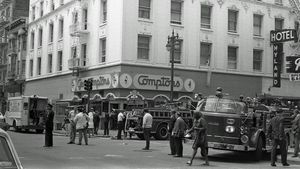May 08 2008 11:00 PM EST
CONTACTCAREER OPPORTUNITIESADVERTISE WITH USPRIVACY POLICYPRIVACY PREFERENCESTERMS OF USELEGAL NOTICE
© 2025 Pride Publishing Inc.
All Rights reserved
All Rights reserved
By continuing to use our site, you agree to our Privacy Policy and Terms of Use.
Day 2: For Art's Sake
For art, there are two must-do's in Venice, the Galleria Dell'Accademia (Campo della Carit? 1050, Dorsoduro; +39-041-520-0345), which supports rooms upon rooms of Renaissance masters and rivals The Uffizi Galleries in Florence; and the Collezione Peggy Guggenheim (Palazzo Venier dei Leoni, Dorsoduro; +39-041-240-5411), just down the block from the Accademia. The American heiress' collection, housed in her former mansion cum garden burial site, runs through every star of modern art: Picasso, Dali, Bacon, Rothko, and Kadinsky, to name drop a few.
Around lunchtime, wander northwest into Dorsoduro towards the studenty Campo Santa Margherita. Whether you eat along the way or stop in the Campo's Pizza Volo (Campo Santa Margherita 2944/a, Dorsoduro; +39-041-522-5430; 2-10 EUR) for a quick, bargain-sized pizza, don't miss the gelato at the Campo's Il Doge (Campo Santa Margherita 3058/a, Dorsoduro; 2-5 EUR).
Admission to the Galleria also gains you admission to the Museo d'Arte Orientale (Santa Croce 2076) and the Ca' d'Oro (Cannaregio 3932; +39-041-522-2349), which are just across the Grand Canal from each other and back up by La Zucca in Santa Croce. In the Ca' d'Oro, as eerie today as it was in the 15th century, hangs Andrea Mantegna's Renaissance masterwork of queer icon, Saint Sebastian.
From the Ca' d'Oro, it's a short walk southeast to the queer-friendly Paradiso Perduto (Fondamenta della Misericordia, Cannaregio 2640; +39-041-720-581), a Bohemian-style restaurant and bar popular with students. Later on, the lights dim and anything from live jazz to heavy, DJ-fuelled dancing can happen.
If you make it to midnight and are still in the Paradiso Perduto neighborhood, it's worth stepping back into Piazza San Marco. After dark and devoid of human bustle, it's not hard to believe you've stepped through time, too.
Day 3: Island Hopping
Beyond the conventional boundaries of Venice lie some of her greatest treasures. Well-worth the fare for its views of the city alone, take a morning trip on Vaporetto 1 to the sandbar island of Lido, where the rich and famous excuse themselves to private beaches every summer. The dunes bordering the beaches at the north and south ends of Lido were once quite cruisey, although that has dropped lately.
After a good wander and some lunch, leave Lido on the private Alilaguna Rossa (+39-041-240-1701; 6 EUR) water bus, which stops at Murano. Master glass craftsmen have packed this small island with factories, hand-making some of the world's most beautiful, impossibly wispy, and gaudy glass creations. Tour a factory if you can, but don't gesture wildly in the gift shop.
The first stop back in Venice proper on Vaporetto 41 or 42 is Fondamente N?ve, just a few blocks from Osteria al Bomba (Calle dell'Oca, Cannaregio 4297; +39-041-520-5175; 10-20 EUR). Nestled down a side street, it hides genial owners, a long, family-style wooden table, and some great typically Venetian seafood.
Heading towards the train station, pass through the historic Jewish Ghetto, where the original wooden doors that once enforced the neighborhood's curfew still stand.
If you are careful or adventurous enough, catch a train to Mestre, the conventionally urban portion of Venice, and check out Porto de Mar (Via delle Macchine in Mestre, 41; +39-346-211-3085), the city's only gay club. Entrance requires a membership card to ArciGay, Italy's national LGBT group, but exceptions are often made for foreigners. The card can be purchased at the club. Be careful to time your return to Venice with the trains, which are just a few blocks from the club, or plan to stay out until 5 a.m. or so.
Part One | Part Two | Part Three
From our Sponsors
Most Popular
Just in Time for Pride – The 15 Gayest Cities in the World in 2023
April 12 2023 6:47 PM
The 13 Least Visited National Parks
January 07 2023 5:00 AM
Get Soaked! with These 35+ Steamy Pool Pics From This Year’s White Party
May 25 2023 9:29 AM
20 Thirsty Pics of #SniffiesRush Campaign Celebrating Frat Life
December 16 2022 3:19 PM
25 Thirsty Pool Party Pics from White Party Palm Springs 2022
April 14 2023 5:55 PM
Sniffies Reveals Horniest Cities
December 22 2022 4:15 PM
15 Thirsty Pics of Moot Lingerie for Men
March 21 2023 7:41 AM
The 7 Best Nude Beaches for Gays in the U.S.
June 09 2022 4:00 AM
The Most Dangerous (& Safest) Countries for LGBTQ+ Travel
March 22 2023 5:00 AM
Outtraveler: Featured Video
Latest Stories
A gay solo traveler goes bear-hunting in Barcelona
November 13 2025 4:31 PM
More than a month: Prioritizing LGBTQ+ health year-round
October 15 2025 12:27 PM
UNITY at Sphere is the perfect Las Vegas attraction for gay tourists
October 03 2025 5:09 PM
Malta is the secret Pride destination where gays are going wild
September 18 2025 4:47 PM
What is a Jubilee? These Catholics just became the first LGBTQ+ people to participate
September 08 2025 12:49 PM
Marriage equality will be banned in these 31 states if Obergefell is overturned
September 08 2025 10:40 AM
Explore the camp, parties, and parade of Provincetown Carnival 2025
September 05 2025 7:03 PM
My big gay Broadway summer
August 27 2025 9:27 AM
Explore Zurich with Swiss style icon Susanne Bartsch
August 25 2025 9:46 AM
Splash House is the secret Pride festival where gays can truly let loose
August 22 2025 9:00 AM
When love sinks, set sail for the Hudson Navigator
August 15 2025 6:00 AM
Need an escape from American anxiety? Consider Colombia.
July 16 2025 11:47 AM
This heavenly hotel in the heart of Hell's Kitchen is the perfect oasis
June 26 2025 6:00 AM
Top 10 LGBTQ+ beach towns perfect for Pride and summer fun
June 05 2025 1:54 PM
Checking out: nhow London, the city’s coolest hotel
June 02 2025 8:45 AM
Cruising the world helped this gay couple find lasting love
May 31 2025 2:45 PM
Gays went feral at an iconic Pride celebration in Pensacola, Florida
May 30 2025 6:00 AM
Wilderness, woods, and Wigstock: Drag icons light up the Catskills
May 28 2025 12:17 PM
Out and About with Christian Cooper
May 28 2025 11:07 AM











































































